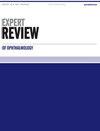先进成像技术在青光眼中的应用
IF 0.9
Q4 OPHTHALMOLOGY
引用次数: 0
摘要
摘要引言成像技术,特别是光学相干断层扫描(OCT),在青光眼的诊断和监测中发挥着重要作用。这篇综述旨在批判性地评价青光眼视神经头(ONH)、视网膜神经纤维层(RNFL)和黄斑成像的最新进展。涵盖的领域该综述侧重于ONH、视网膜和相关结构的成像,确定了五个广泛的主题;1) RNFL、ONH和黄斑的成像;2) OCT血管造影术(OCTA);3) 结构功能分析;4) 视网膜成像的新方法(OCT和OCTA之外);以及5)人工智能(AI)。讨论了影像学在青光眼诊断和进展分析中的应用。专家意见RNFL、黄斑和ONH的测量显示出类似的检测青光眼的能力,尽管大多数OCT诊断能力研究受到病例对照设计的限制。黄斑和ONH参数,如Bruch膜开口最小边缘宽度(BMO-MRW),可能对视盘外观异常或高度近视的眼睛更有用,但应注意规范参考数据库的局限性。影像学不应取代视野检查,尤其是用于监测进展情况。可能会开发同时测试结构和功能的设备,并使用贝叶斯统计方法集成结果。本文章由计算机程序翻译,如有差异,请以英文原文为准。
The application of advanced imaging techniques in glaucoma
ABSTRACT Introduction Imaging technologies, especially optical coherence tomography (OCT), have an important role in glaucoma diagnosis and monitoring. This review aims to critically appraise recent developments in imaging of the optic nerve head (ONH), retinal nerve fiber layer (RNFL), and macula in glaucoma. Areas covered The review focuses on imaging of the ONH, retina, and associated structures, identifying five broad themes; 1) imaging of the RNFL, ONH and macula; 2) OCT angiography (OCTA); 3) structure function analysis; 4) novel methods of retinal imaging (beyond OCT and OCTA); and 5) artificial intelligence (AI). The use of imaging for glaucoma diagnosis and progression analysis is discussed. Expert opinion Measurements of RNFL, macular, and ONH have shown similar ability to detect glaucoma, though the majority of OCT diagnostic ability studies are limited by case-control design. Macular and ONH parameters such as Bruch’s membrane opening-minimum rim width (BMO-MRW) may be more useful in eyes with unusual optic disc appearance or high myopia, though the limitations of normative reference databases should be appreciated. Imaging should not replace perimetry, particularly for monitoring progression. Devices are likely to be developed that test structure and function concurrently, with results integrated using Bayesian statistical approaches.
求助全文
通过发布文献求助,成功后即可免费获取论文全文。
去求助
来源期刊

Expert Review of Ophthalmology
Health Professions-Optometry
CiteScore
1.40
自引率
0.00%
发文量
39
期刊介绍:
The worldwide problem of visual impairment is set to increase, as we are seeing increased longevity in developed countries. This will produce a crisis in vision care unless concerted action is taken. The substantial value that ophthalmic interventions confer to patients with eye diseases has led to intense research efforts in this area in recent years, with corresponding improvements in treatment, ophthalmic instrumentation and surgical techniques. As a result, the future for ophthalmology holds great promise as further exciting and innovative developments unfold.
 求助内容:
求助内容: 应助结果提醒方式:
应助结果提醒方式:


